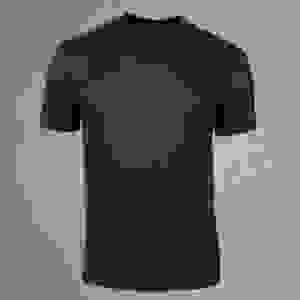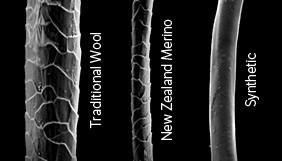There’s an interesting pattern that emerges from perusing the packing lists of long-term (or frequent) backpackers; they end up using eerily identical sorts of gear. You’ll see surprisingly consistent suggestions, such as using down jackets for warmth, traveling with just one pair of do-it-all shoes, using tiny airplane bottles, and so on. I call it the “objectivity funnel.” Despite the broad range of circumstances long-term backpackers run into, there’s an objectively correct answer (at least conceptually) to just about every situation. And one of the most consistently suggested items for travelers of all sorts is a merino wool t-shirt. Everyone will tell you to get one. Or two or three.

There’s a good reason for this. Cotton and polyester, which seemingly comprise 99% of the t-shirt world, have a number of irritating liabilities that simply won’t go away, which become especially problematic when subjected to the sorts of conditions that long-term backpackers often encounter.
- Cotton is incapable of drying quickly, meaning it’ll hold onto moisture all day long, so hand-washing clothes is nearly impossible. If you perspire heavily in the middle of winter, the moisture will stay all over you, sucking body heat away and slowly destroying your soul, a tragedy which I discovered the hard way in a below-freezing Italian winter with inadequate gear. I literally crawled under one of those hand dryers in a random bathroom to warm my chilled bones. Cotton is a problem in the heat as well; if you’re sweating heavily all day, particularly in humid weather, your t-shirt will become a sopping wet ordeal within a matter of hours.
- Polyester has a different sort of problem, as it dries quickly enough that it won’t accumulate horrific amounts of sweat, but it will accumulate horrific amounts of body odor. The smooth surface of the fiber is a spectacular breeding ground for bacteria, particularly when it’s hot and sweaty. Entire civilizations of microorganisms will rise and fall within the synthetic fibers of your snazzy polyester t-shirt, producing waste products that cause offensive and socially unacceptable smells. And it doesn’t matter if you’re using deodorant. That’ll make you smell fine, but not the fabric, where the colony will thrive. Polyester is also non-absorbent, meaning that when moisture has nowhere to go (if you’re sitting against a plastic chair, or carrying a pack), it’ll just sit there, feeling like a wet garbage bag. It’ll smell like one, too. Plenty of anti-odor treatments exist (it’ll say so in the product description if it has one) but they’re not always present, and occasionally ineffective.
Merino wool has none of these problems.
Why merino wool t-shirts work so well

As any long-term backpacker (whether traveler or mountaineer) will tell you, merino wool has something of a legendary reputation for comfort (mentally and physically), in a broad range of situations, from summer heat to winter chill, and outdoorsy adventures to lazy hostel lounging. It’s incredibly versatile, which is absolutely essential to shrinking a gigantic pack to practically nothing, particularly if you’re going to put it through the rigors of extreme temperature fluctuations and rivers of sweat flowing down your torso.
Merino wool pros:
- Merino wool is an excellent insulator, keeping you warm in the winter, and cool in the summer…within limits, of course, but much better than cheaply produced polyester t-shirts, which can often make you feel like you’re stuck in an oven.
- Merino wool is absorbent (unlike polyester, which just lets moisture sit stickily on the surface), but merino actually absorbs moisture to the interior of the fiber, whereas the surface pushes moisture away. This means it can actually be somewhat damp, yet still feel completely dry, which is a big part of the reason it’s so comfortable.
- It dries a lot faster than cotton; usually not as fast as polyester (though different fabrics vary), but fast enough that you can generally wash a merino wool t-shirt in the sink at night, and hang it up to dry by morning. Colder climates (and early risers) will make this more difficult, but only by a matter of hours. It also means you can go on a 12 hour hike and won’t be sopping wet by the end, because moisture won’t continuously accumulate like it does with cotton.
- It will never accumulate body odor. You will smell, but your clothing will not. The surface of the fiber provides a horrible environment for bacterial growth, so it just doesn’t survive. No bacteria, no smell. Mountaineers have literally worn the same outfit for several months at a time with no problems. If you’re wandering around in burning hot sunshine all day and then you have to walk into a hostel and hope to be socially acceptable, this is a huge deal.
- It otherwise looks and feels just like cotton, AKA it’s super soft and comfy, and doesn’t look techy. It can be a little out of place wearing polyester t-shirts all the time (particularly when the vast majority of those are about as shiny as the chrome plating on a brand new car, and have just as many ventilation panels, showy logos, and racing stripes), whereas merino just looks like a regular t-shirt (although I can tell the difference, because I’m obsessed with these things).
- Compared to other types of wool, merino has the additional benefit of not itching…at all. It’s a much finer fiber than “regular” wool (and often treated to soften the microscopically scaly surface of the fiber, which usually causes the itching), so if you’ve tried wool before and it drove you insane, it’s worth giving merino wool a try. You might legitimately be allergic to wool, but it might just be that you’ve been trying the wrong kind this whole time. I can’t wear a regular wool sweater for more than five minutes without going crazy, but I can wear merino forever.

These advantages come at a price, however. Pun intended.
Merino wool cons:
- They’re horrifyingly pricey…like, $70 for a t-shirt. It will very likely be your favorite t-shirt, and if you’re rotating through just a few items, you only need a few of them…but whether it’s worth the cost or not will depend on how seriously you make use of the advantages listed above.
- Bugs will eat them! Silverfish and moths will be your arch nemeses. People rarely run into these problems, particularly if the items are stuffed in a backpack, but it’s worth taking into consideration if you happen to see bugs like these. On the upside, merino wool is flame-resistant (whereas polyester burns immediately), so there’s a durability pro/con tradeoff here.
- They’re somewhat less durable than slick and smooth polyester. This is generally only a problem with really vigorous hand washing, which can eventually degrade the fabric, whereas with smooth polyester, you can scrub all day long as hard as you can, and nothing will happen. Thus if you’re hand washing merino wool, it’s a good idea to scrub a little more softly (and use more soap and water for extra cleaning power) so it’ll last longer. They don’t need to be washed that often anyway, but it’s still good to be gentle on a $70 item. Durability is comparable to high-quality cotton t-shirts, so this isn’t a “problem,” aside from the fact that you’ll want to maximize the lifespan more so than you would with anything else.
So! Are merino t-shirts worth the cost?

Many people will tell you that merino wool is so vastly superior in terms of comfort and versatility that there’s simply no reason to bother with anything else, and, if you aren’t in a financial mess, they’re correct. But I’m somewhat more price-sensitive than “just get them, they’re awesome,” because at $70 (or more) per t-shirt, it’s simply out of reach for a lot of people. Ironically, they’re especially out of reach for budget-stricken college-age backpackers on their way to sweltering summer climates where merino wool works amazingly well. Life is annoying that way.
So I’m going to describe the situations where merino wool works best, so you can decide if the cost/benefit analysis is worth it for you. The more you make use of merino wool’s spectacular features, the more it’ll become worthy of the investment.
You should probably invest in merino wool if:
- You need a minimum of clothing that handle whatever. Hot, cold, and everything in between, through long days of brisk walks through humid tropics, followed by sociable evenings that start too soon for you to take a shower. The more climate variations you’ll encounter, and the more you exert yourself throughout the day, the more sense it makes to use merino.
- If you sweat all day, every day, and have horrific problems with workout clothing smelling horrible after just a few hours of intense use, or cotton accumulating so much sweat that you feel like you’re wearing a wet sponge.
- You hate the sticky feeling of polyester, but still want something quick-drying, whether for comfort, or ease of hand washing.
- If you’re heading into snowy mountains, where you’ll be sweating ridiculously on steep uphill climbs, with windswept peaks with appallingly freezing wind chill, where moisture next to the skin will ruin your whole day.
As you may have guessed, merino wool is most useful at extreme temperatures (and trips that involve wild temperature fluctuations), and, if you’re traveling, I would argue that it’s more likely that this will be relevant in hot weather, as you’ll gain the advantages of moisture management and odor resistance, which are most important in sweaty conditions. It’s relevant in warm weather as well, since sweating lightly for 12 hours is going to create just as good a breeding ground for offensive bacteria as sweating heavily for 2 hours.

Merino also works nicely in cold weather, as it still manages to insulate, even when somewhat wet, and dries quickly enough that you can stay warm, which is critical if you’re sweating heavily in winter. I would say this is probably more important for hiking backpackers, and somewhat less important for travel backpackers, because travelers sometimes have a backpack which makes them sweat ridiculously (before they drop it off at the hostel), but hikers pretty much always do. Hikers also can’t duck into a coffee shop and sip a hot drink whenever they feel like it, or throw their stinky used clothing into a laundry machine, whereas travelers usually can.
You won’t need it if:
- You’re walking around in cool weather, you’re not sweating, and you have a warm-enough jacket anyway. If you’re wandering around town at a leisurely pace that doesn’t result in immense perspiration, merino wool’s moisture management and odor resistance are largely irrelevant. In cold weather it’s useful, since any perspiration might literally start freezing, but that only comes into play if you’re exerting yourself. In mild conditions at a slow pace, you can get by cheaply with ordinary clothing. Particularly if…
- You also have continuously available laundry facilities. If you plan on washing everything in a machine anyway, you’ll just take a shower whenever you feel the need to do so, and put on a brand new set of clothes afterwards. If you’re in mild weather and you weren’t even sweating much anyway, the performance advantages of merino wool will pretty much be invisible all day, and the quick-drying fabric will be mostly irrelevant if you’re also doing a machine wash.
I would actually argue that if you’re planning on a trip where the weather is going to hover between room temperature and slightly-cooler room temperature with a zero percent chance of rain, you don’t need performance clothing of any kind. It’s mostly in the crushingly brutal temperature extremes that high-tech clothing is most useful, and, when you’re traveling (or hiking), you often run into this a lot, and you don’t always have a home to hide inside of, so your only means of shelter is clothing. And it had damned better be good.

I’ve been through ridiculously blazingly hot summers, and brutally below-freezing winters, and got locked in a damn Italian train station overnight with inadequate gear in the middle of winter, where my stupid body decided to perspire all night long for no stupid reason, and since pretty much all I had was cotton, that sweat stayed there. Let me tell you, being wet and cold in the middle of winter while locked in a train station at 4am is the worst. Damn you, Italy. Damn you!
But that’s why merino wool is so beloved by scruffy backpackers all over the world. It’ll regulate your body temperature, pull excess moisture away from your body and let it evaporate, and it’ll look, feel, and smell great the whole time, no matter what sorts of nonsense you get yourself into. So no, it’s not that you “need” merino wool, but, if you find yourself ending up in these ridiculous situations over and over again, merino will make you feel a whole lot better than just about anything else.
Where can I get some?
Lots of people make merino wool t-shirts nowadays, so you’ll have plenty of options, from outdoorsy merino wool companies that specialize in the fiber, such as Icebreaker, Smartwool, Ibex, and Minus33, and outdoor/travel/performance companies such as Patagonia, Rohan, Outlier, and Wool & Prince, all of which have good options.
Aside from personal preferences on style and fit, the one thing you’ll want to look for is the fabric weight; 150 grams per square meter is a pretty standard, “normal” t-shirt weight, and good for a wide range of climates and situations. Some go down to 120 (which will be super light, but much more delicate), and up to 200 (which will be much stronger, but maybe too warm for the tropics).
Minor side note: Personally I prefer to wear nothing but t-shirts as a base layer (even when part of a winter packing list), because that way you can strip down to a t-shirt if you’re too warm, and leave the insulation to the other layers. Packing multiple t-shirts is also lighter than packing multiple thermal long underwear tops, and much easier to wash and hang dry as well. So regardless of where you’re going, I’d say just bring regular t-shirts, and add more layers when it’s cold.
Merino wool also makes great dress shirts, which not only do everything you see here, but are also completely immune to wrinkles! I’ve compiled a brief list here. Never iron anything ever again!
Is there anything comparable to merino t-shirts?
Yup! There’s magical miracle fabric out there that pretty much does everything merino wool does, and could probably be sold at half the price. It’s called Tencel, and nobody uses the damn thing. Argh!

Well, that’s not true. They use it for women’s clothing, because apparently only women enjoy feeling comfortable!?!? Argh again! But oh well. If you happen to have two X chromosomes, take a look at Nau, Royal Robbins, and Horny Toad, all of which have a billion Tencel options for ladies. It’s also called lyocell, so keep an eye out for that too. It drives me crazy how this is somehow a women’s fabric even though men sweat lots more. Argh!!!
I finally managed to find a couple things for men made out of the damn thing, and it shares a lot of the same properties as merino, but actually dries faster, which is why I keep blathering on and on about it. I’d love to see a t-shirt made out of this material, because I think it could be a great budget-friendly (and vegan) alternative to the tried-and-true merino wool t-shirt that everyone loves. Tencel is highly absorbent, quick drying, odor resistant, environmentally sustainable, and ridiculously soft. I can’t entirely determine at this point whether it’ll work just as well as merino (I literally cannot find a men’s t-shirt made purely of Tencel), but it feels great, and people should just start using it already.
What if I’m too poor?
If you simply can’t spend $70 on a t-shirt, have no fear. A decent budget alternative is simply to use a cotton/polyester blend t-shirt, which will give you the benefits of both fibers; it’ll be soft and absorbent, but quick-drying and shrink-resistant. It won’t be as good as merino, particularly when it comes to odor resistance (most cotton/polyester t-shirts are intended to be cheap, so they don’t bother with additional anti-odor treatments), but it’ll do.
I’m voting for Uniqlo’s Dry Packaged Crew, which is only $6 per t-shirt, and is pretty great. Not wear-it-three-days-in-a-row great, but maybe one or two, particularly in cool-to-warm (rather than cold-to-hot) weather. It’s made of seemingly higher-quality materials than anything I’ve seen at this price, and it’ll allow you to deal with sink washes and intense sweating fairly well, and for $6 each, you can spend the extra cash on other important things, like beer.
I would also add that if you’re traveling, it’s not a bad idea to bring one outfit you don’t mind ruining; a cheap polyester t-shirt makes a good “I’m going on a hike for 2 hours and showering afterward” layer, since you don’t have to worry about body odor in that case, and polyester t-shirts can be as cheap as $10, and if they get destroyed on a thorn-filled jungle trek, you won’t care.
Well, I hope you’ve enjoyed me going into ridiculous detail (I certainly did!), but I also hope this’ll help people make a better decision as to whether or not it’s worth dropping $300 on a few new t-shirts. Everyone will tell you they’re totally worth it, but I think it’s worth knowing exactly why. It’s a major investment, but a merino wool t-shirt is very likely going to be your new “I wish this were my only shirt” shirt.




I have bought a lot of gear based on your recommendations; Bluffworks and Rohan – just to name a few. I really appreciate your reviews and website.
A friend of mine was raving about this t-shirt he had (he is a Marine Combat Vet) and said that he wore it over in the Middle East and highly recommended it for back-packing.
It is made by a company call Potomac Field Gear. Here is the link:
https://store.potomacfieldgear.com/store/comersus_viewItem.asp?idProduct=139
I was wondering if you ever heard of them, tried it out, or had an opinion on it.
I was looking to buy some undershirts for my trip in July (Africa) and was looking at these – however before I do any shopping I usually visit your site first. Do I splurge on Merino Wool or try these Potomac shirts….
Love for you to check them out and give us (me) some feed back.
I usually avoid merino wool for undershirts, because it can get pretty warm. It depends on what you’re doing, but usually if you’re wearing two different shirts, it gets pretty warm, especially if the outer shirt is long-sleeved, which is why I try to find the lightest undershirts possible. I don’t have a particular favorite at the moment (I don’t wear buttoned shirts that often), but modal is a great natural-feeling undershirts fabric, and ultra-thin polyester (like Uniqlo’s Airism) are good for quick-drying needs.
I work for two technical apparel companies, Marmot and ExOfficio, and still love learning new things about technical clothing. Thanks for shedding light to this topic in only the way you do.
Cheers,
Nick
No problem. I’m happy that I can finally put all this dorky knowledge to use somehow. Also, I’m a big fan of the Marmot Mica. I don’t know why nobody else does rain jackets as light as Marmot, but now I don’t have to bother with anything else.
Icebreaker just made a polo blending merino wool with your other favorite natural fiber, tencel. Thought you might want to know!
Eddie Bauer has developed a fabric which they call Travex. It’s essentially 69% Tencel Lyocell and 31% Polyester. Travex boasts performance features such as UPF sun protection, moisture wicking, wrinkle free, breathable, water repellent, quick drying, and more. I have several of the shirts which I bought simply based on how they looked on me without knowing they were Tencel-based. I have to say they wear great and are some of my favorite shirts.
That sounds good. They’ve been using the Travex name for a while, though I think they apply it to whichever items they make that work for travel, rather than just a specific fabric. I’m pretty sure they’ve had some nylon/polyester shirts that work too, though a Tencel version would feel more natural.
I’m sorry I messed up the HTML tags, I hope this time I will succeed!
For US residents :
Fjällräven tencel/lyocell shirts
Icebreaker wool shirt
Kühl wool shirt
I’m not affiliated w/ 6pm, but I think those prices are good, unfortunately I couldn’t buy (and send via my friend from US) all of those, because I’m a fairly tall guy¨(197cm or 6’5″), so only Fjällräven sizes matched me :-)
It’s funny, a few hours ago the prices on Icebreaker and Kühl were lower (Fjällräven was the same).
Maybe 6pm has good BI-tools and checks the clicks and play w/ prices!?
Thanks for writing up a great article!
It seems merino wool is a big deal these days. There are many companies jumping on the wave. There are also merino wool blending with cotton, polyester, and Tencel for people with sensitive skin, or looking for something different.
My favorite merino wool T-Shirt is from Outlier. I’m a bit biased, I’ve been a big fan for a long time. I only own two Outlier merino wool T-Shirts due to the cost, they are worth it! I’ve had them for three years, wearing them almost everyday, and they are still like new. I love Outlier quality! I took them to SE Asia this past January, they were great for sleeping and lounging around. They were a bit hot in warm and humid weather for me.
I actually preferred wearing the Arcteryx Phase SL and linen T-Shirt in hot and humid weather.
The Phase SL is a polyester blend with silver-ion for odor control. This material is very thin, silk like feel, and very fragile. While it does not insulate when wet like merino wool, it does wick and dry very fast. Arcteryx make several T-Shirt versions using the Phase SL material. I used the base layer version, layering with a linen button-up long sleeve most of my trip. I would wash them at night using the Scrubba Washing Bag, and my clothes are dry by morning.
Linen T-Shirt was actually my second preference for the SE Asia weather. Linen also has natural anti-microbial properties, absorbs moisture and dry better than cotton, it’s stronger than cotton, and feels great after many years. Linen blend with cotton or ramie is great on softness, and wrinkle a little less.
Icebreaker and Smartwool both have merino/tencel blends this year (as I’m writing this, anyway), and I expect they’ll become popular. I should probably give linen a try at some point. Linen/tencel or linen/merino could be good. I have a hemp/cotton shirt from Royal Robbins, and I think hemp has similar properties compared to linen, though I haven’t gotten a chance to try that in hot weather yet.
What do you know about Modal? Like the shirts from Swrve. They also have some nice looking soft shell pants.
Modal feels great, although it doesn’t dry quickly. It’s perfect for people who just want a comfy t-shirt, and have access to laundry machines, and plan on using them as everyday t-shirts or whatever. I prefer the quick-drying properties of Tencel, but of course that’s a universal necessity.
Still looking for that tencel t-shirt? Fjällräven makes one called the Abisko Trail T-shirt, 85% tencel/15% wool. They sell them in lots of colors with only a tiny logo on the left chest, color matched to the shirt so it doesn’t jump out. They’re great shirts and super comfy. I don’t remember this being in their lineup before. Have they been reading your blog? Hehe
FINALLY. That looks like a good one to try. Merino is still great for insulation when wet (which seems to be Tencel’s only downside), but it’s mostly Tencel, so it should dry quickly and it keeps the cost down. The merino/Tencel t-shirt from Nau is pretty good, but I think they actually use a thicker fabric, so it’s not quite summer-appropriate.
And I’ve always made of point of complaining as loudly as possible, as it’s the only way to make things change.
Hah! I have the same philosophy. Fjällraven also make a button down shirt out of 100% Lyocell called the Abisko Vent, long and short sleeve versions. Fjällräven is worth a look. Most of what they make is trail oriented but they do have some nice travel clothing that doesn’t look like travel clothing.
Icebreaker now makes a merino/tencel/nylon shirt call the cool-lite. I won a free sample and so far it looks promising. My guess is the wool/synthetic mix fabric will continue to grow.
I’ve seen that one recently, and from their product description, it sounds like it does exactly what I was expecting. It wicks and dries faster, so it might work even better in summer heat. Sounds like Tencel doesn’t insulate when wet, so it’s more of a summer item than a winter item (particularly up in the mountains) but that’s less of a problem with travel, and if it dries fast enough, it might work just fine.
Check out merino wool shirts at kitclothiers.com. They are creating high quality 100% New Zealand merino wool shirts for everyday life, not just to wear outdoors.
i hacked 100% merino wool sweaters from target into t-shirts. the sweaters were on sale for $15 including tax and delivery. even h&m has sweaters for $20. they are pretty thin, so they are closer to heavy t-shirts. with a little elastic, the sleeves make nice arm warmers.
That’s a good idea. Uniqlo sells theirs pretty cheaply, and they’re super thin. Maybe a little see-through, though…